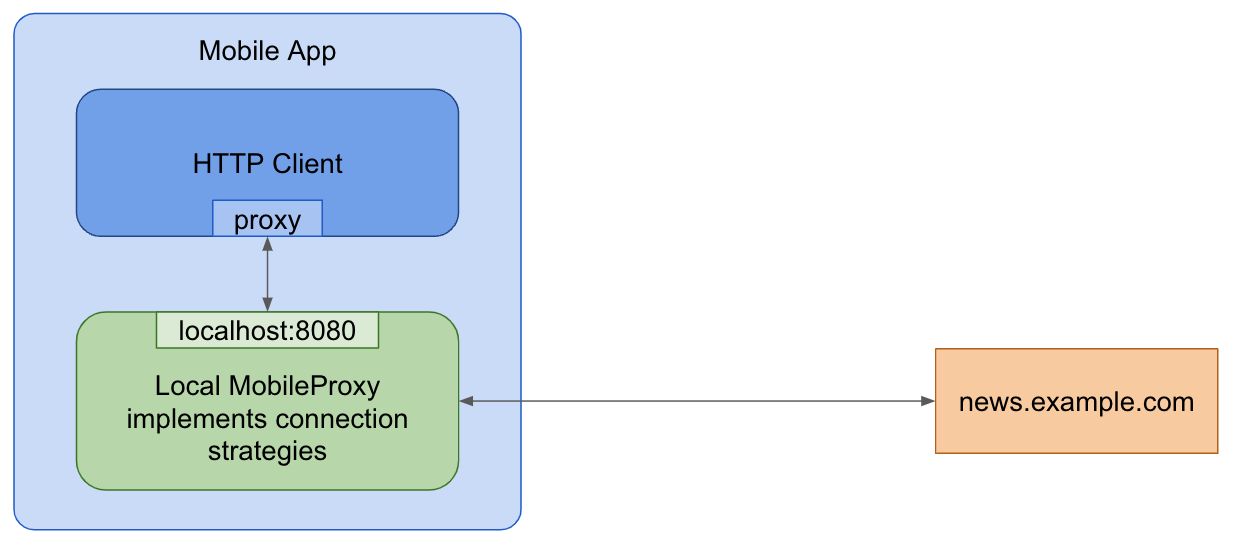In dit document leggen we uit hoe je de Outline SDK integreert in je mobiele apps. We richten ons hierbij op de MobileProxy-bibliotheek voor eenvoudig beheer van lokale proxy's.
MobileProxy is een Go-gebaseerde bibliotheek, gemaakt om de integratie van proxyfuncties in mobiele apps te stroomlijnen. De bibliotheek gebruikt Go Mobile om mobiele bibliotheken te genereren. Zo kun je de netwerkbibliotheken van je app instellen om verkeer door een lokale proxy te routeren.
App zonder MobileProxy

App met MobileProxy

Stap 1: Mobiele MobileProxy-bibliotheken ontwerpen
Gebruik gomobile om de Go-code te compileren in bibliotheken voor Android en iOS.
Kloon de Outline SDK-repository:
git clone https://github.com/Jigsaw-Code/outline-sdk.git cd outline-sdk/xOntwerp de binaire bestanden voor Go Mobile met
go build:go build -o "$(pwd)/out/" golang.org/x/mobile/cmd/gomobile golang.org/x/mobile/cmd/gobindPsiphon-ondersteuning toevoegen
Je kunt ondersteuning voor het Psiphon-netwerk toevoegen door deze extra stappen te volgen:
- Vraag het Psiphon-team om een configuratie waarmee je toegang krijgt tot hun netwerk. Je moet hiervoor misschien een contract aangaan.
- Voeg de Psiphon-configuratie die je hebt gekregen toe aan het gedeelte
fallbackvan jeSmartDialer-configuratie. Ontwerp de MobileProxy met de markering
-tags psiphon:go build -tags psiphon -o "$(pwd)/out/" golang.org/x/mobile/cmd/gomobile golang.org/x/mobile/cmd/gobind
De markering
-tags psiphonis vereist omdat de Psiphon-codebase is gelicentieerd onder de GPL, waardoor er licentiebeperkingen kunnen gelden voor je eigen code. Je kunt overwegen een speciale licentie bij ze aan te vragen.Genereer mobiele bibliotheken en voeg ze toe aan je project:
Android
PATH="$(pwd)/out:$PATH" gomobile bind -ldflags='-s -w' -target=android -androidapi=21 -o "$(pwd)/out/mobileproxy.aar" github.com/Jigsaw-Code/outline-sdk/x/mobileproxySelecteer in Android Studio de optie Bestand > Project importeren… om het gegenereerde
out/mobileproxy.aar-pakket te importeren. Ga voor meer hulp naar Building and deploying to Android van Go Mobile.iOS
PATH="$(pwd)/out:$PATH" gomobile bind -ldflags='-s -w' -target=ios -iosversion=11.0 -o "out/mobileproxy.xcframework" github.com/Jigsaw-Code/outline-sdk/x/mobileproxySleep het
out/mobileproxy.xcframework-pakket naar het Xcode-project. Ga voor meer hulp naar Building and deploying to iOS van Go Mobile.
Stap 2: Voer de MobileProxy uit
Initialiseer en start de lokale MobileProxy-proxy binnen de runtime van je app.
Je kunt een statische transportconfiguratie gebruiken of de Smart Proxy gebruiken voor dynamische strategieselectie.
Statische transportconfiguratie: Gebruik de functie
RunProxymet een lokaal adres en lokale transportconfiguratie.Android
import mobileproxy.* val dialer = StreamDialer("split:3") // Use port zero to let the system pick an open port for you. val proxy = Mobileproxy.runProxy("localhost:0", dialer) // Configure your networking library using proxy.host() and proxy.port() or proxy.address(). // ... // Stop running the proxy. proxy.stop()iOS
import Mobileproxy let dialer = MobileproxyStreamDialer("split:3") // Use port zero to let the system pick an open port for you. let proxy = MobileproxyRunProxy("localhost:0", dialer) // Configure your networking library using proxy.host() and proxy.port() or proxy.address(). // ... // Stop running the proxy. proxy.stop()Smart Proxy: De Smart Proxy selecteert dynamisch DNS- en TLS-strategieën gebaseerd op specifieke testdomeinen. Je moet de configuratiestrategie opgeven in YAML-indeling (voorbeeld).
Android
val testDomains = Mobileproxy.newListFromLines("www.youtube.com\ni.ytimg.com") val strategiesConfig = "..." // Config YAML. val dialer = Mobileproxy.newSmartStreamDialer(testDomains, strategiesConfig, Mobileproxy.newStderrLogWriter()) // Use port zero to let the system pick an open port for you. val proxy = Mobileproxy.runProxy("localhost:0", dialer) // Configure your networking library using proxy.host() and proxy.port() or proxy.address(). // ... // Stop running the proxy. proxy.stop()iOS
import Mobileproxy var dialerError: NSError? let testDomains = MobileproxyNewListFromLines("www.youtube.com\ni.ytimg.com") let strategiesConfig = "..." // Config YAML. let dialer = MobileproxyNewSmartStreamDialer( testDomains, strategiesConfig, MobileproxyNewStderrLogWriter(), &dialerError ) var proxyError: NSError? // Use port zero to let the system pick an open port for you. MobileproxyRunProxy("localhost:0", dialer, &proxyError) // Configure your networking library using proxy.host() and proxy.port() or proxy.address(). // ... // Stop running the proxy. proxy.stop()
Stap 3: Stel HTTP-clients en netwerkbibliotheken in
Stel in dat je netwerkbibliotheken het lokale proxyadres en -poort gebruiken.
Dart/Flutter HttpClient
Stel de proxy in met HttpClient.findProxy.
HttpClient client = HttpClient();
client.findProxy = (Uri uri) {
return "PROXY " + proxy.address();
};
OkHttp (Android)
Stel de proxy in met OkHttpClient.Builder.proxy.
val proxyConfig = Proxy(Proxy.Type.HTTP, InetSocketAddress(proxy.host(), proxy.port()))
val client = OkHttpClient.Builder().proxy(proxyConfig).build()
JVM (Java, Kotlin)
Stel via de systeemeigenschappen in welke proxy moet worden gebruikt:
System.setProperty("http.proxyHost", proxy.host())
System.setProperty("http.proxyPort", String.valueOf(proxy.port()))
System.setProperty("https.proxyHost", proxy.host())
System.setProperty("https.proxyPort", String.valueOf(proxy.port()))
Android WebView
Pas een proxyconfiguratie toe op alle webweergaven in je app met de androidx.webview-bibliotheek:
ProxyController.getInstance()
.setProxyOverride(
ProxyConfig.Builder()
.addProxyRule(this.proxy!!.address())
.build(),
{}, // execution context for the following callback - do anything needed here once the proxy is applied, like refreshing web views
{} // callback to be called once the ProxyConfig is applied
)
iOS WebView
Vanaf iOS 17 kun je een proxyconfiguratie toevoegen aan een WKWebView met het kenmerk WKWebsiteDataStore:
let configuration = WKWebViewConfiguration()
let endpoint = NWEndpoint.hostPort(host: NWEndpoint.Host(proxyHost), port: NWEndpoint.Port(proxyPort)!)
let proxyConfig = ProxyConfiguration.init(httpCONNECTProxy: endpoint)
let websiteDataStore = WKWebsiteDataStore.default()
websiteDataStore.proxyConfigurations = [proxyConfig]
let webview = WKWebView(configuration: configuration)
Geavanceerd: Een aangepaste mobiele bibliotheek maken
Voor geavanceerde use cases kun je je eigen mobiele bibliotheken maken:
- Een Go-bibliotheek maken: Ontwikkel een Go-pakket waarin de vereiste SDK-functies zijn verpakt.
- Mobiele bibliotheken maken: Gebruik
gomobile bindom Android ARchives (AAR) en Apple Frameworks te produceren. Voorbeelden: - Integreren in je app: Voeg de gemaakte bibliotheek toe aan je mobiele app.
